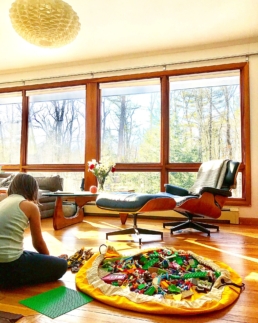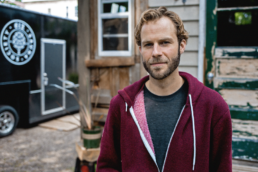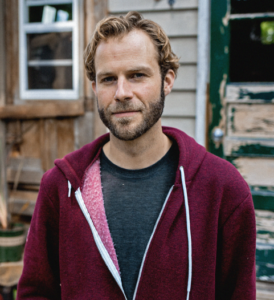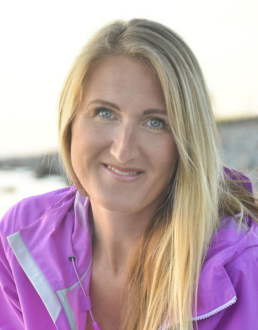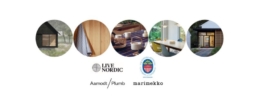A Sneak Peek at 5 Nordic Homes in America
Take a sneak peek at these five Nordic homes spreading from Reno Nevada to Coastal New England, all embodying Nordic simplicity, timelessness and natural materials.
Read how these homeowners celebrate their Nordic heritage and learn what features they value the most when creating a Nordic inspired space for themselves and their families.
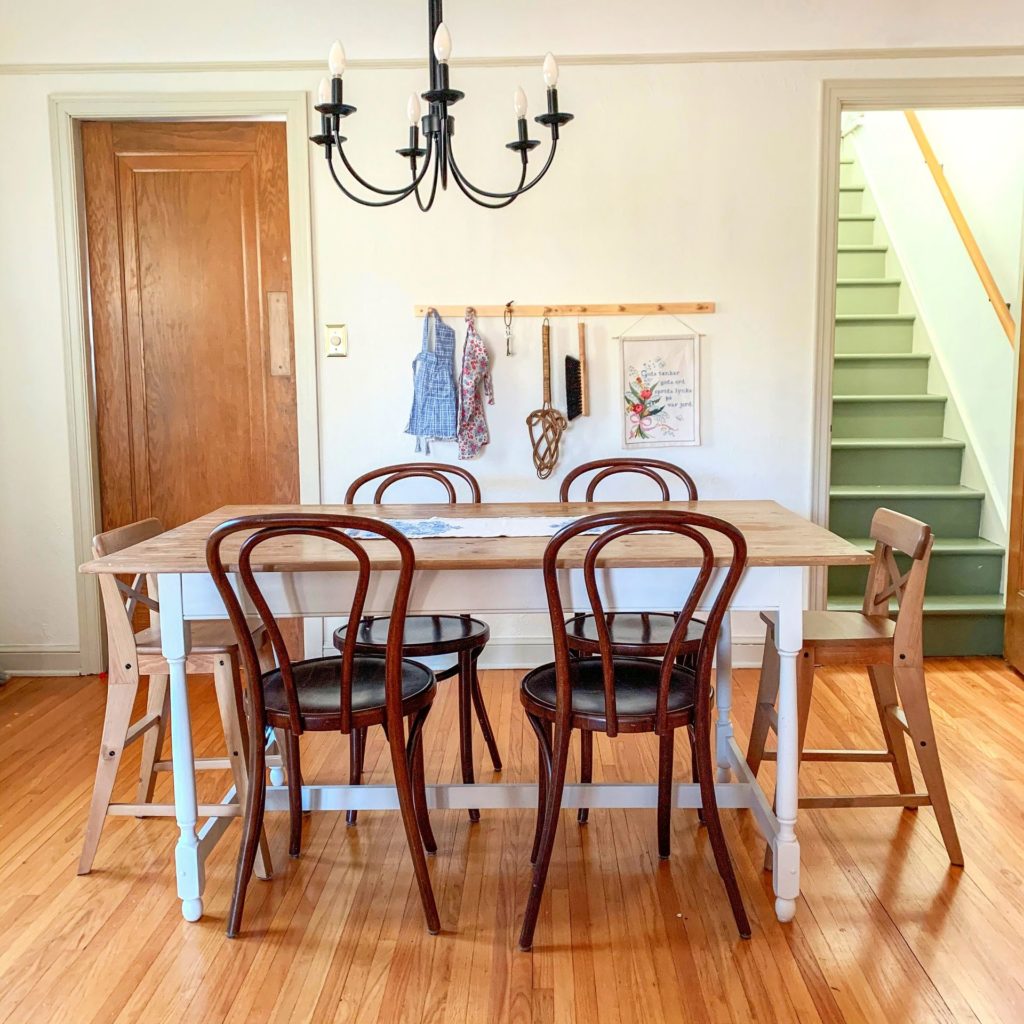
Home location: Minneapolis, Minnesota
Who lives here: Annette Wind from Sweden, stay at home mother of three, husband Andrew and children Emmett, Fiona and Enid (and two dogs and six chickens!)
“When I created the dining room space my roots from the Swedish country side really took over and everything I picked out seemed to represent the land I was brought up in. Everything from the knotty pine table, the green stairs inspired by Swedish farmhouse, to the little embroidered wall hanging with a Swedish saying made by my late grandmother made this room feel like a little piece of Sweden in my American homestead.”
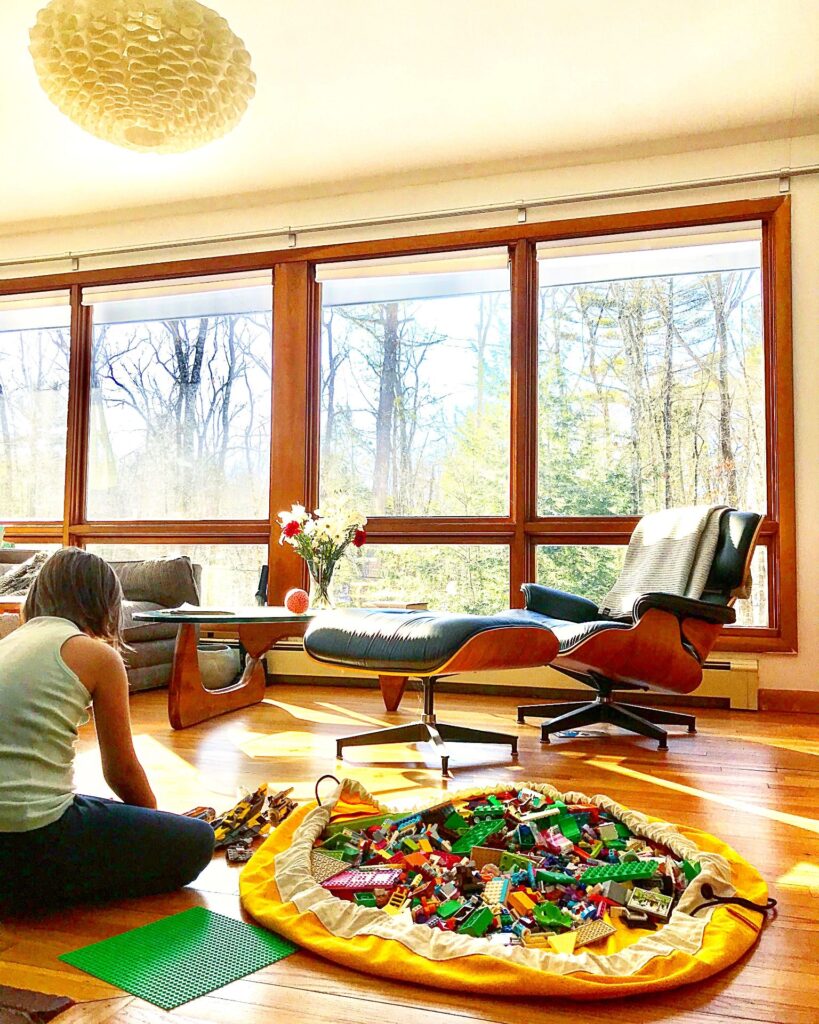
Home location: Leverett, Massachusetts
Who lives here: Leah, owner of Ittikid, her Swedish husband Calle, and their daughters Tuva and Elsa.
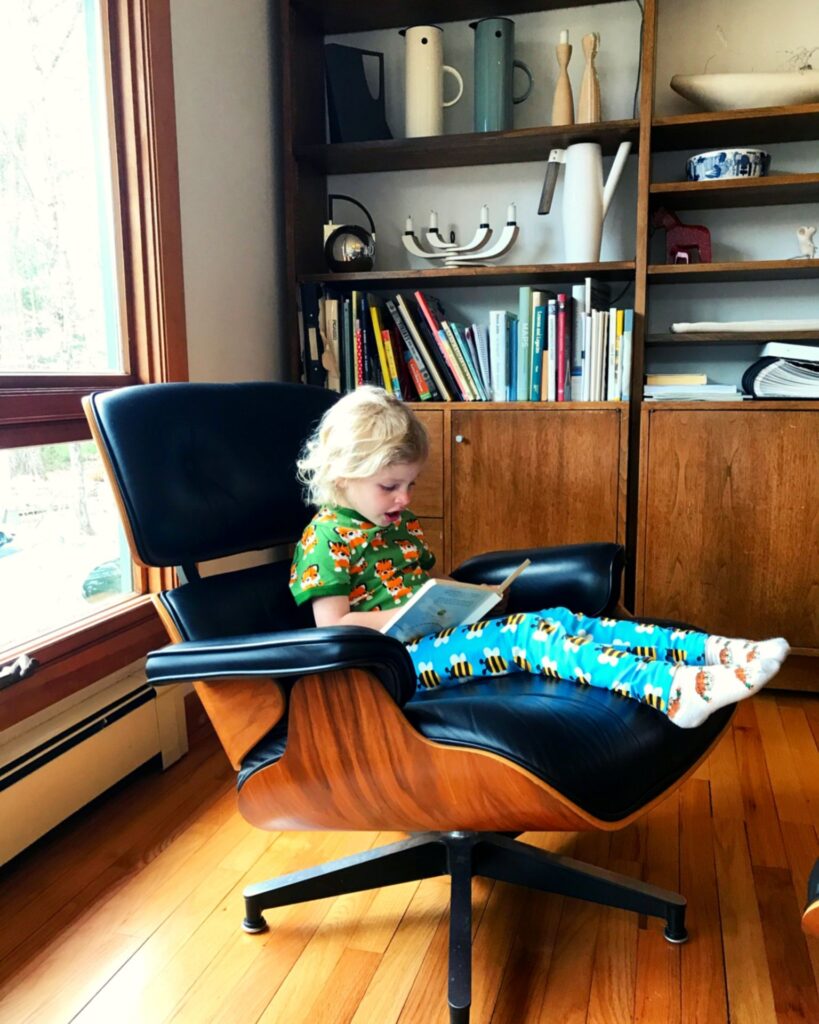
“As a Swedish-American family, we love incorporating Scandinavian design into our everyday life and home. Many of the pieces in our home are vintage Danish or Finnish mid-century pieces that my grandparents bought in the 60’s and the rest are pieces we’ve carefully brought home in our suitcases from our annual trips to visit Calle’s family in Sweden. One of our favorite spots to curl up with a book or zonk out after we get the kids to bed is in our Eames lounger with our vintage Danish shelf behind it. My grandparents had this shelf in their homes for the past 60 years, and we have now made it our own and styled it with our favorite ceramics & Dala horses from Sweden, and Stelton pitchers from Copenhagen. My grandfather and I used to read together in their Eames lounger throughout my childhood, and it took me years to save up and buy one once we bought our first house. In fact, this was the first item I purchased as soon as my business became profitable, and used my first paycheck on it — ha! I love reading in the chair next to their old Danish bookshelf, and seeing our girls read Pippi stories to each other in the chair now. I love seeing how kids breath life into these iconic pieces & help pull our home together with a nod to both of our cultures and histories.”
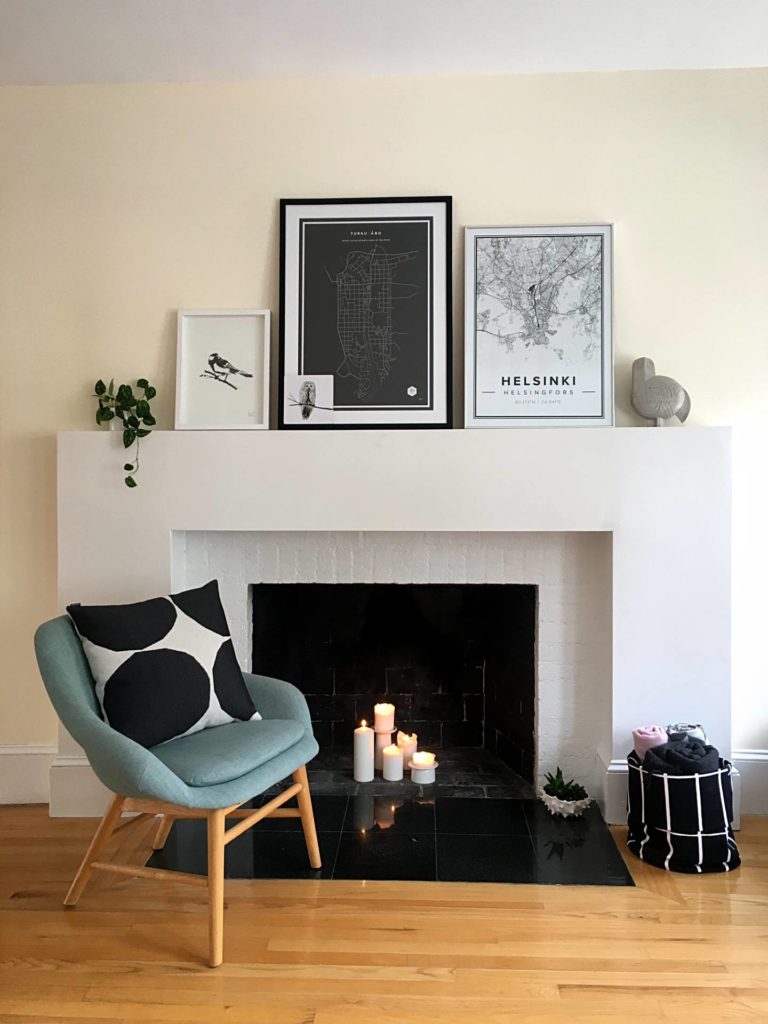
Who lives here: Mia Suni from Finland, founder of Studio M, her husband Fabrice and children Stella and Noa.
” My favorite Nordic spot in our Brookline (MA) home is the fireplace nook in our living room. One way I like to cherish my Nordic roots is through Finnish art that I have placed on the mantel. Cozy Marimekko textiles are another important design element for me. The fireplace area provides a natural environment for art and being a ceramicist myself I often “display” my own creations in this area. Art in general is a quick and easy way to celebrate your heritage. I think this spot captures both the coziness and typical clean lines of Nordic interiors. The longer I’ve lived abroad the more important these elements have become to me.”
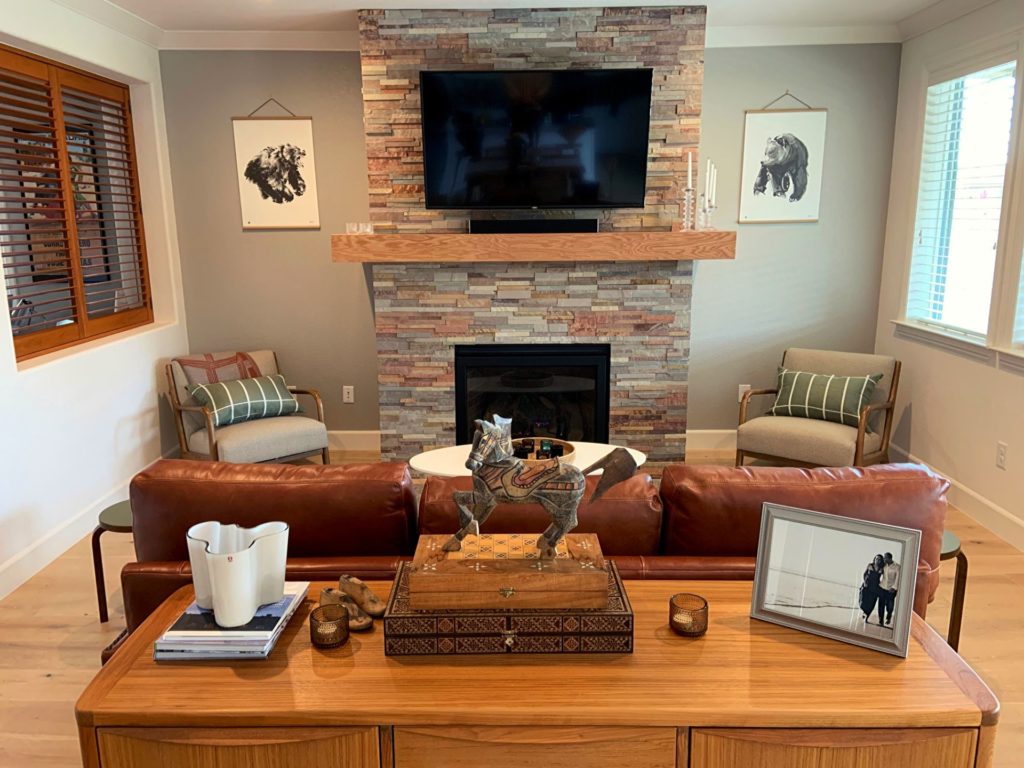
Home location: Reno, Nevada
Who lives here: Annika Caldwell from Finland, founder of NØRDIK, her husband and 3 Rhodesian Ridgebacks (Zulu, Imbasa and Mbali).
“My favorite spot in our Reno (NV) home is our open concept living room and kitchen (full of Finnish glassware and tableware from Iittala and Arabia of course!). I have decorated our home blending Sierra Nevada mountain style with Nordic design inspired by nature. Finnish artist Teemu Järvi Illustrations artwork fits perfectly with the natural elements we are surrounded by. I have also incorporated some of the timeless Finnish design pieces from designers such as Alvar Aalto, Timo Sarpaneva and Oiva Toikka. I use sustainable linen and wool textiles from Lapuan Kankurit, such as the wool throw in my living room combined with accent linen cushion covers from Marimekko. As you can tell I tend to favor warm and calming earth tones to create a comfortable (and natural) home. I also mix in elements from around the world such as the decorative antique horse from Guatemala and handmade game boxes from Syria.”
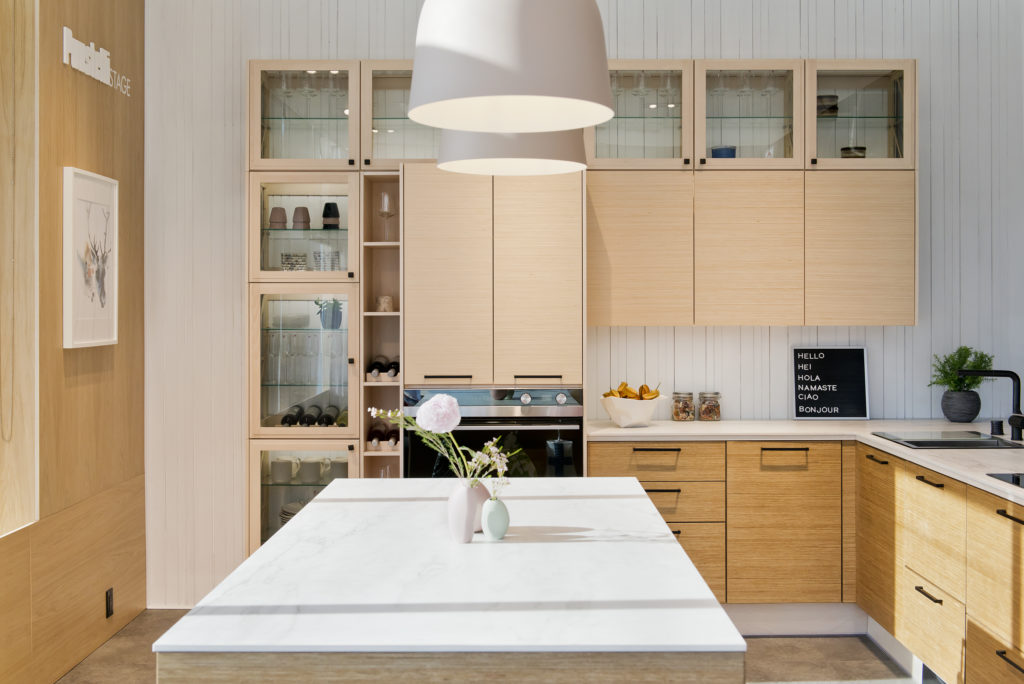
Home location: Minneapolis, Minnesota
Who lives here: Anna Juola from Finland, co-founder of Puustelli USA, her husband Mikko and their three children.
“My favorite space in our home is our kitchen. For us, kitchen is much more than just a place to prepare meals and eat – it is a center of our family life and a best place for us to socialize, bond and come together throughout our daily activities. My husband and I are in kitchen business, so I guess it’s natural that we are passionate about kitchens, food and everything in that category, and consider our kitchen as the heart of our home”.
John Pederson - the 612 Sauna Society Cooperative
Sauna Cooperative Bringing Steam Bathing to Urban America
Who: John Pederson
Current Gig: Founder of the 612 Sauna Society Cooperative and Sauna Society Outfitters
Location: Minneapolis Minnesota USA
Favorite way to relax: Ahhhhh, in the SAUNA of course!
“Since the dawn of humanity, humans around the world have gathered to enjoy the simple pleasures of steam and heat. The sweat bathing traditions of the world have been preserved by their responsiveness to the needs of modern societies”, explains John Pederson, the Founder of the 612 Sauna Society and Sauna Society Outfitters, both organizations sprouting from the Twin cities area. Founded in 2016, the 612 Sauna Society is the nation’s first member owned Sauna Cooperative and the Sauna Society Outfitters was established two years later, to offer the experience of steam bathing through trainings, events and product development.
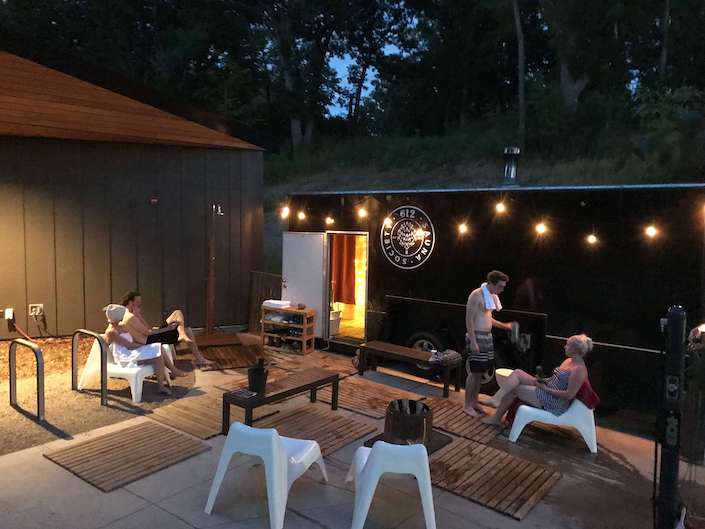
“…in today’s fast-paced, distracted, divided and noisy world — the therapeutic potential of steam bathing has never been more obvious or more needed.”
John Pederson could be called a pioneer in making Sauna relevant and “cool” in urban America. Since building his first Sauna in 2014, John has hosted over 5,000 guests for sauna gatherings at venues he has created or managed throughout the Twin Cities. Today the 612 Sauna Society has over 150 members, and it owns and operates a mobile sauna unit called the Forge. The Forge has been hosted by dozens of businesses and neighborhood organizations in the Minneapolis area.
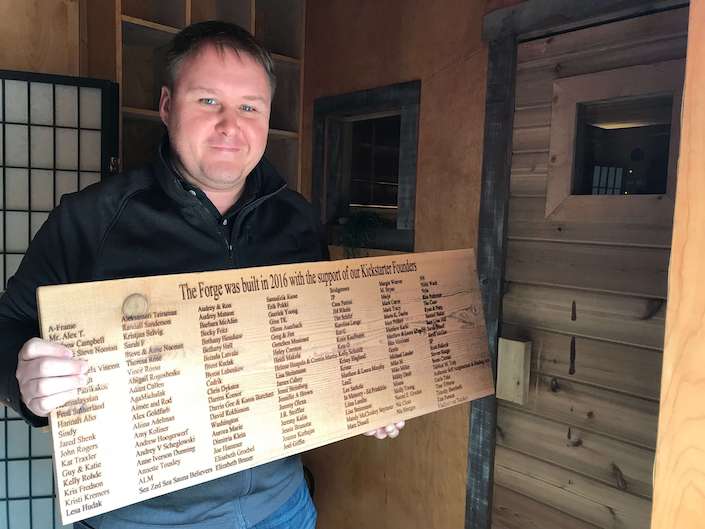
In addition to his gig as a Chief Fire Wood Officer at the 612 Sauna Society, John’s other venture, the Sauna Society Outfitters, now organizes guided steam sessions at Hewing Hotel in downtown Minneapolis, followed by a cool down relaxation round and an optional ice bath reset.
We hope that what John has created is just a beginning for a movement to make Sauna a bigger part of urban life in America. As people search new ways to manage anxiety and stress caused by the demands modern society, sauna can improve mental and physical wellness, in addition to the social benefits it generates.
It’s been inspiring to follow John’s journey of making sauna tradition more relevant in North America, particularly for younger generations. We chatted with John about the future of sauna in America and its role in our everyday life.

LN: We think of Sauna as something so inherently Nordic. What does Sauna represent to you?
JP: I think of sauna as one of many Sweat Bathing traditions. Since the dawn of humanity humans around the world have gathered to enjoy the simple pleasures of steam and heat. The sweat bathing traditions of the world have been preserved by their responsiveness to the needs of modern societies. The Finns started calling it Sauna, the Turks Hammam, the Native Americans Sweat Lodge, and the Russians Banya. Each culture developed different customs and practices around the experience to best serve their time, place and communities.
LN: Why has the 612 Sauna Society Cooperative become so popular among the local communities in Minnesota?
JP: Today, the therapeutic potential of steam bathing has never been more obvious or more needed. As a 308B cooperative organization, our Board of Directors is voted in by our Membership on a one-to-one basis (each member has one share and each share gets one vote). The purpose and advantage of this governance is to keep our organization responsive to the needs and priorities of its Member-Owners. In doing so, we are discovering the therapeutic potential of sauna today and actively participating in the preservation of one of the finest traditions of The North.
“I would love to see more innovated projects making the physical, mental and social benefits of steam bathing traditions more available to all.”
LN: Is there anything about Sauna that you consider to be a unique kind of experience that you cannot find elsewhere?
JP: It’s a very unique experience, especially in today’s fast-paced, distracted, divided and noisy world. In these times, the therapeutic potential of steam bathing has never been more obvious or more needed.
LN: How would you like to see the culture and traditions of sauna evolving in America in a few years’ time?
JP: I would love to see more innovated projects making the physical, mental and social benefits of steam bathing traditions more available to all. I would love to see more Sauna Co-ops.
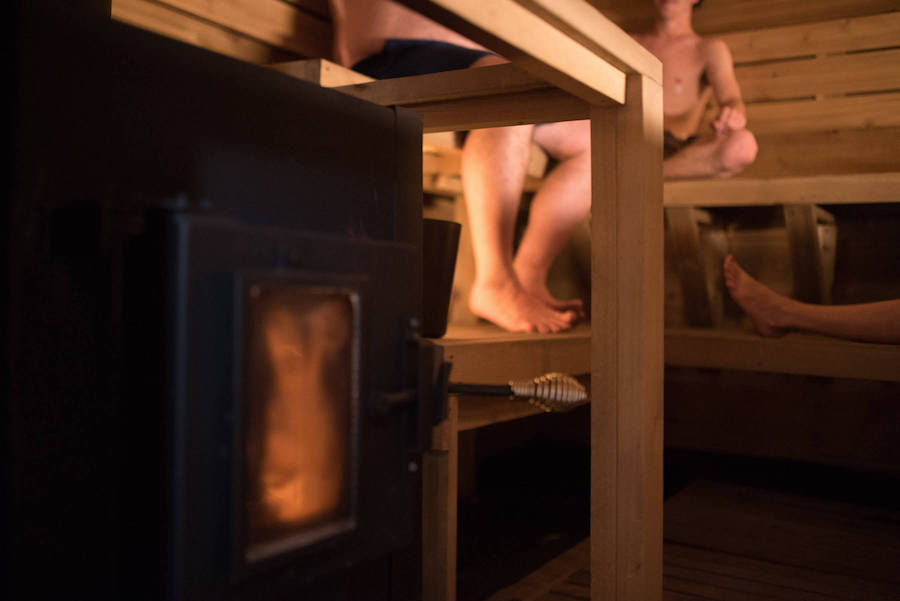
Linda Åkeson McGurk - Rain or Shine Mamma
Muddy, Happy, Healthy
Who: Linda Åkeson McGurk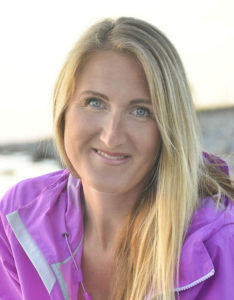
Current Gig: Journalist, blogger, author and advocate for all-weather play
Location: Splits time between Sweden and Indiana
Favorite way to relax: Walking in the forest
One of the fundamental parts of living Nordic is spending a great deal of time outdoors and connecting with nature. In the North, where winters are long and summers short, people have learned to embrace each season and children are encouraged to play outside in any weather, all year round.
We had an inspiring chat with Linda Åkeson McGurk, a Swedish American journalist, blogger, and author of the parenting memoir There’s No Such Thing As Bad Weather: A Scandinavian Mom’s Secrets for Raising Healthy, Resilient, and Confident Kids (from Friluftsliv to Hygge), about the benefits of all-weather play.
Linda is a fierce advocate for the Nordic outdoor tradition and believes that the best childhood memories are created outside, while jumping in puddles, digging in dirt, catching bugs and climbing trees. In 2013, she started the blog Rain or Shine Mamma to chronicle the adventures of her own two wildlings and to inspire other parents and caregivers to get outside with their children every day, regardless of the weather.
Linda shares her best tips on how to adopt the principles of an outdoor lifestyle – what the Scandinavians call friluftsliv - at home regardless of where you live.
LN: “There's no such thing as bad weather, only bad clothes", exemplifies the Nordic understanding about the value of spending time outdoors, regardless of the weather. What do you think the tipping point will be for a more widespread understanding of the value of all weather play for children?
LM: I think there’s a lot of momentum for the movement to get kids back outside right now, so these are exciting times for sure. Just ten years ago, when I had my first daughter, “forest school” – a preschool where kids spend most or all of the day learning outside, all year round – was an unknown concept in the US. It’s still not exactly a household term, but the number of forest schools have grown from just one in 2006 to several hundred today.
Even though far from everyone has the opportunity to enroll their child in a forest school at this point, I think the growth of this type of early childhood education will go a long way toward normalizing all-weather play for children. When people see these happy, healthy, muddy forest school kids playing in nature, I think they realize on a very intuitive level that this is what young kids should be doing, not spend their days sitting at desks and filling out worksheets. And for the skeptics, there’s fortunately a lot of research being published about the benefits of outdoor play that backs up the notion that being outside every day, rain or shine, is good for kids.
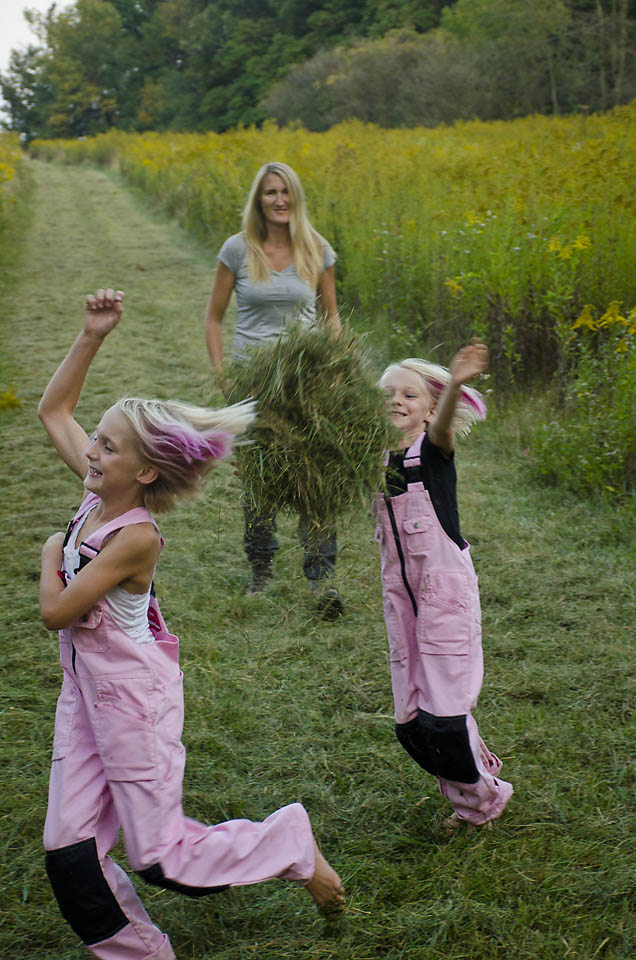
"Being outside every day, rain or shine, is good for kids."
LN: What role, if any, do you see the rise of technology playing in advancing our understanding of the value of outdoor play? Have you seen any apps or technology that promote outdoor play?
LM: I think technology gives us many wonderful tools to promote and learn more about outdoor play – just look at all the grassroots outdoor organizations that are connecting and inspiring parents online today. Most of them wouldn’t even exist if it weren’t for the internet and social media. Having said that, I also think excessive technology use among kids is one of the biggest and most common challenges for parents today, and we know that there’s a gross imbalance between time spent in front of screens and time spent playing outside.
"Even very young kids now use electronic media frequently. -- I think that makes it harder for them to appreciate the slow entertainment offered by nature."
Even very young kids now use electronic media frequently and get hooked on instant gratification and constantly being entertained, and I think that makes it harder for them to appreciate the “slow entertainment” offered by nature. I’ve seen many kids even lose their sense of wonder. That’s just one of the reasons why I lean toward delaying screen time for younger children and restricting it for the older ones.
I know there are apps that are meant to entice kids to go outside and explore, but the issue that I’ve run into when I’ve tried a few of them, is that the kids become more interested in the screen than what’s going on around them. When that happens, the screen becomes a barrier to rather than a facilitator of nature connection. But to each their own, and for kids who are not used to playing in nature, a mobile app may bridge the gap.
"I think there’s a lot of momentum for the movement to get kids back outside right now, so these are exciting times for sure."
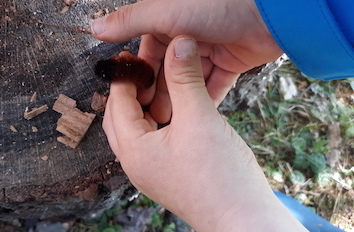
LN: Nordic societies provide infrastructure that encourages children’s independence at young age and all-weather play is a norm at schools and daycare centers. What practical advice can you give to parents who want to follow the Nordic philosophy of giving children more freedom to play outside on their own and take risks, but find it challenging due to limited access to green areas, a lack of safe bike/walking routes to school or a wide variety of other reasons?
LM: Parents in the Nordic countries are very lucky insofar that outdoor play is supported on so many levels of society, but I think it’s possible to adopt the principles of an outdoor lifestyle – what the Scandinavians call friluftsliv - at home regardless of where you live. The key is in committing to getting outdoors daily, to make it part of your family rhythm. If you have a backyard, great! That’s an entire world of wonder for little kids and a great place for them to start exploring. And by all means, invite the neighbors’ kids!
"Children need risk in order to grow."
I think one of the reasons people are afraid to let their kids out today is a lack of social trust and you can help fix that by getting to know the people in your community. Even if you don’t have a backyard, get outside in your neighborhood and come back to the same places often, to give your child a chance to develop a sense of place. Challenge yourself to gradually give your child more and more freedom to take risks and explore without supervision.
Unfortunately, we live in a culture of fear – fear that our kids will get abducted, hurt themselves, fall behind at school, and all these fears are taking a toll on outdoor play. Some fears are more justified than others, but that doesn’t change the fact that children need risk in order to grow. Some of the biggest health challenges facing children right now are obesity, diabetes, ADHD, anxiety and depression. Outdoor play can help prevent and reduce the symptoms of all of those, so the biggest risk of all may very well be sitting on the couch.
But even though creating a culture of friluftsliv starts at home, it shouldn’t end there. For those who live in places where green-spaces, sidewalks and bike routes are scarce, get involved in your community and advocate for a change. There are no quick fixes, but you’ve got to start somewhere and there are many inspirational examples out there of communities where small changes have made a big difference.
“...obesity, diabetes, ADHD, anxiety and depression. Outdoor play can help prevent and reduce the symptoms of all of those.”
LN: What are you working on now?
LM: My book There’s No Such Thing as Bad Weather was just published in Poland, so I’m anticipating some media appearances there in the near future. Publishers in Turkey and Vietnam have bought the rights for it as well, so that’s coming up next. Meanwhile in the US, the paperback version of the book is coming out at the start of October. It’s so exciting to see the message of the book spread to different countries and to see progress, even if it’s slow at times. I also have several events planned in Chicago, New Jersey and New York City at the end of October. (Check out my Facebook page Rain or Shine Mamma for details.) My plan is to keep inspiring, educating and advocating through public speaking, my blog and social media – it’s my calling.
“The key is in committing to getting outdoors daily, to make it part of your family rhythm.”

Linda is touring the US in October
Linda has several events planned in Chicago, New Jersey and New York at the end of October. Check out her Facebook page Rain or Shine Mamma for details.
Go To Linda's Facebook Page https://www.facebook.com/rainorshinemamma/
Nordic Design Exploration
Live Nordic's first event, Nordic Design Exploration, was a success. We want to thank everyone who was able to join us and showed so much enthusiasm for Nordic life. Special thanks to our wonderful organizational partners, the Swedish American Chamber of Commerce of New England, Marimekko and Aamodt/ Plumb Architects, for supporting our mission and making Live Nordic's first event a reality.
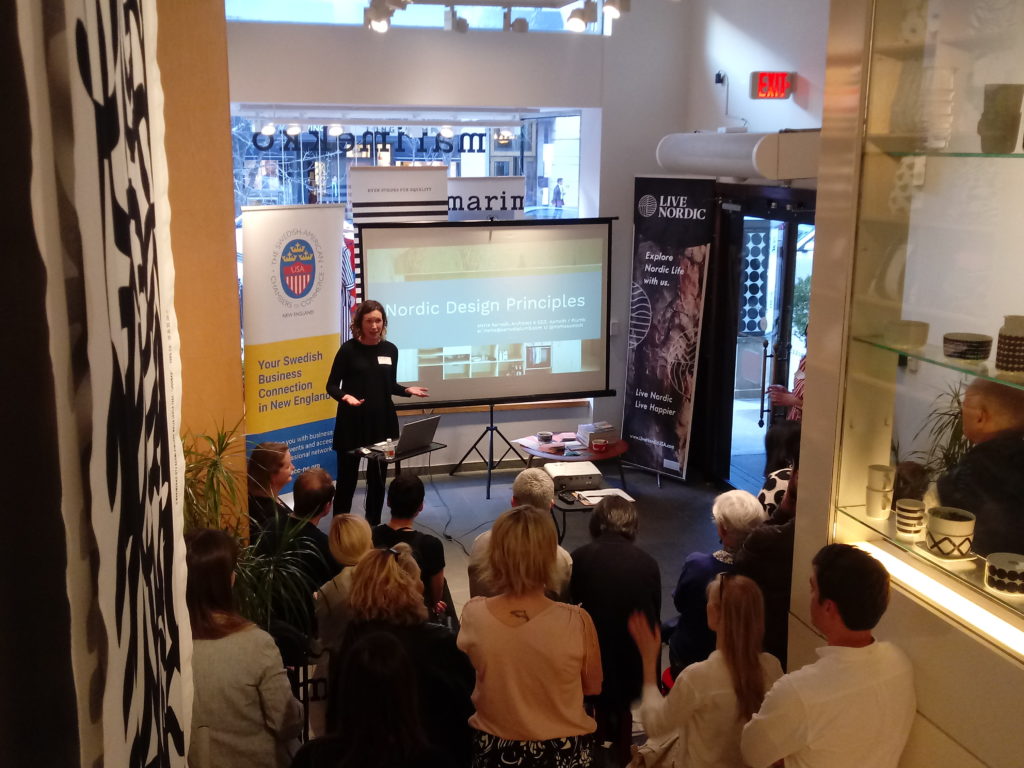 The speaker of the night, Mette Aamodt, helped us explore the principles of Nordic Design. We learnt that Nordic Design is very much a reflection of Nordic values such as equality, openness, social responsibility and domesticity. Things are not necessarily designed to be pretty, but rather functional, timeless and durable pieces that fit the Northern lifestyle and values.
The speaker of the night, Mette Aamodt, helped us explore the principles of Nordic Design. We learnt that Nordic Design is very much a reflection of Nordic values such as equality, openness, social responsibility and domesticity. Things are not necessarily designed to be pretty, but rather functional, timeless and durable pieces that fit the Northern lifestyle and values.
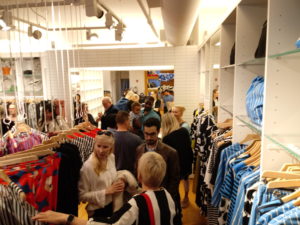
We can't wait to bring more Nordic life your way. Live Nordic - Live Happier. Stay tuned for more!

